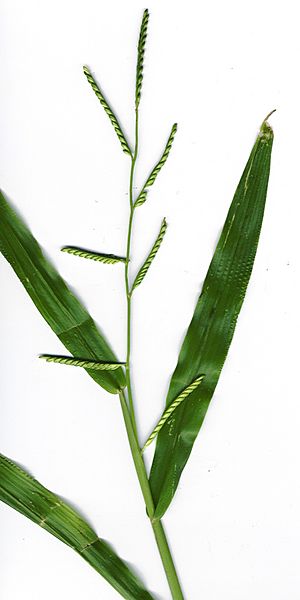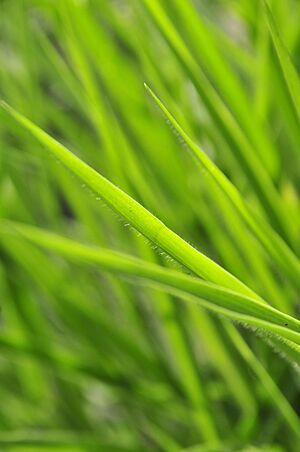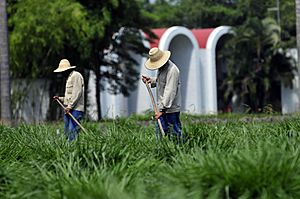Brachiaria facts for kids
Quick facts for kids Brachiaria |
|
|---|---|
 |
|
| Brachiaria plantaginea | |
| Scientific classification | |
| Kingdom: | |
| (unranked): | |
| (unranked): | |
| (unranked): | |
| Order: | |
| Family: | |
| Genus: |
Brachiaria
(Trin.) Griseb., 1853
|
| Type species | |
| Brachiaria eruciformis (Sm.) Griseb.
|
|
| Synonyms | |
|
|
Brachiaria, also known as signalgrass, is a type of plant that belongs to the grass family. These grasses naturally grow in warm, tropical and subtropical parts of the world. You can find them in Asia, Africa, Australia, southern Europe, the Americas, and on many islands. There are more than 100 different kinds, or species, of Brachiaria.
Some of these grasses are grown on purpose to be used as forage. Forage is plant material eaten by grazing animals, like cows. Brachiaria was likely brought to the Americas by accident a long time ago, possibly on ships during the colonial period. For example, B. decumbens arrived in Brazil in 1952. Today, Brachiaria is the most common tropical grass used in Central and South America. About 40 million hectares (which is a huge area!) are planted with it in Brazil alone.
Contents
About Brachiaria Grasses
This group of grasses was first described in 1853. Brachiaria is quite similar to another grass called Panicum. Some scientists even think Panicum might be an older relative. It has also been confused with Urochloa. However, most of the time, you can tell Brachiaria and Urochloa plants apart.
Brachiaria grasses can be annuals, meaning they live for one growing season, or perennials, meaning they live for more than two years. Most do not have rhizomes, which are underground stems. The plant usually grows to about one meter (about 3 feet) tall. Its flowers grow in a branching cluster called a panicle. The flowers have both male and female parts. They also have three anthers, which are parts that produce pollen. Some types of Brachiaria have a clear vein in the middle of their leaves. These grasses are also special because they use a process called C4 carbon fixation. This helps them grow well in dry, sunny places.
Where Brachiaria Lives
Brachiaria can grow in many different places. It can be found in wet swamps, shady forests, or even very dry areas like semideserts. However, it usually grows best in savannas and other open, warm environments, like those in East Africa. For example, in Angola, a type called B. brizantha grows on termite mounds. In Kenya, Brachiaria is a main plant found on the ground, along with another grass called Aristida. In India, a native Brachiaria species, B. ramosa, is an important food for birds like the Eurasian collared dove. Other local plant-eating animals also eat Brachiaria species.
In North America, a native type called broadleaf signalgrass (B. platyphylla) grows quickly after heavy rains. It can spread very fast and sometimes becomes a weed in gardens or farms.
Many large areas in warm regions, especially in Central and South America, have been turned into Brachiaria pastures. These pastures are used to feed livestock like cattle. In Brazil, about 80 million hectares of natural habitat have been planted with African grasses, mostly Brachiaria.
Sometimes, when plants are brought to a new place (called introduced species), they can affect the local environment. For example, in Northern Australia, the introduced B. decumbens competes with a native tree called Alphitonia petriei. It can stop the young trees from growing. This makes it harder for abandoned pastures to return to natural forests. However, in other places, like Paragominas in Brazil, the native forests can grow better than the planted Brachiaria pastures. Also, some native animals, like the rock cavy (a type of rodent), can use the introduced Brachiaria as a food source.
Growing Brachiaria
Brachiaria is the most important type of grass grown for pastures in warm parts of the world. Different kinds of Brachiaria can even grow in poor or acidic soils. Brazil is a major country that uses and produces Brachiaria seeds in the Americas.
Mexico has worked to improve its trade in Brachiaria plants. This grass is believed to have helped their milk and beef industries a lot. Countries in Central America have also increased how much Brachiaria seed they sell and how much land they plant with it. For example, between 2009 and 2010, seed sales grew by 32% in Mexico and 62% in Honduras.
Like other crops, Brachiaria can be affected by pests. Some common insect pests include spittlebugs, leafcutter ants, and mound-building termites. Other insects that can harm Brachiaria include certain types of shoot flies and caterpillars.
Types of Brachiaria
There are many different species of Brachiaria:
- Brachiaria adspersa
- Brachiaria advena
- Brachiaria albicoma
- Brachiaria ambigens
- Brachiaria antsirabensis
- Brachiaria argentea
- Brachiaria arida
- Brachiaria arizonica
- Brachiaria arrecta
- Brachiaria atrisola
- Brachiaria bemarivensis
- Brachiaria benoistii
- Brachiaria bovonei
- Brachiaria breviglumis
- Brachiaria brevispicata
- Brachiaria brizantha
- Brachiaria burmanica
- Brachiaria capuronii
- Brachiaria chusqueoides
- Brachiaria ciliatissima
- Brachiaria clavipila
- Brachiaria comata
- Brachiaria coronifera
- Brachiaria decaryana
- Brachiaria decumbens
- Brachiaria deflexa
- Brachiaria dictyoneura
- Brachiaria dimorpha
- Brachiaria distachya
- Brachiaria distachyoides
- Brachiaria dura
- Brachiaria echinulata
- Brachiaria eminii
- Brachiaria epacridifolia
- Brachiaria eruciformis
- Brachiaria falcifera
- Brachiaria fasciculata
- Brachiaria foliosa
- Brachiaria fragrans
- Brachiaria fruticulosa
- Brachiaria fusiformis
- Brachiaria gilesii
- Brachiaria glomerata
- Brachiaria grossa
- Brachiaria holosericea
- Brachiaria humbertiana
- Brachiaria humidicola
- Brachiaria jaliscana
- Brachiaria jubata
- Brachiaria kurzii
- Brachiaria lachnantha
- Brachiaria lactea
- Brachiaria lata
- Brachiaria lateritica
- Brachiaria leandriana
- Brachiaria leersioides
- Brachiaria leucacrantha
- Brachiaria lindiensis
- Brachiaria longiflora
- Brachiaria lorentziana
- Brachiaria malacodes
- Brachiaria marlothii
- Brachiaria megastachya
- Brachiaria mesocoma
- Brachiaria meziana
- Brachiaria mollis
- Brachiaria multiculma
- Brachiaria munae
- Brachiaria mutica
- Brachiaria nana
- Brachiaria nigropedata
- Brachiaria nilagirica
- Brachiaria notochthona
- Brachiaria oblita
- Brachiaria occidentalis
- Brachiaria oligobrachiata
- Brachiaria ophryodes
- Brachiaria orthostachys
- Brachiaria ovalis
- Brachiaria paucispicata
- Brachiaria perrieri
- Brachiaria piligera
- Brachiaria plantaginea
- Brachiaria platynota
- Brachiaria platyphylla
- Brachiaria polyphylla
- Brachiaria praetervisa
- Brachiaria psammophila
- Brachiaria pseudodichotoma
- Brachiaria pubescens
- Brachiaria pubigera
- Brachiaria pungipes
- Brachiaria ramosa
- Brachiaria remota
- Brachiaria reptans
- Brachiaria reticulata
- Brachiaria rugulosa
- Brachiaria ruziziensis
- Brachiaria scalaris
- Brachiaria schoenfelderi
- Brachiaria semiundulata
- Brachiaria semiverticillata
- Brachiaria serpens
- Brachiaria serrata
- Brachiaria serrifolia
- Brachiaria stefaninii
- Brachiaria stigmatisata
- Brachiaria subquadripara
- Brachiaria subrostrata
- Brachiaria subulifolia
- Brachiaria tanimbarensis
- Brachiaria texana
- Brachiaria tsiafajavonensis
- Brachiaria turbinata
- Brachiaria umbellata
- Brachiaria umbratilis
- Brachiaria urochlooides
- Brachiaria urocoides
- Brachiaria uzondoiensis
- Brachiaria villosa
- Brachiaria whiteana
- Brachiaria windersii
- Brachiaria wittei
- Brachiaria xantholeuca
See also
 In Spanish: Urochloa para niños
In Spanish: Urochloa para niños



